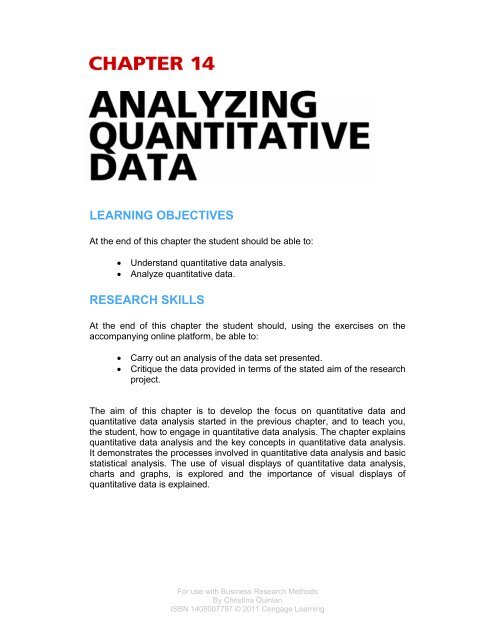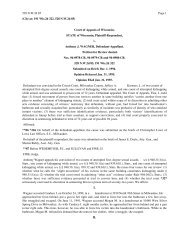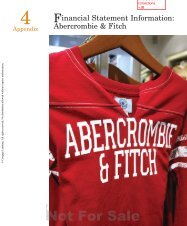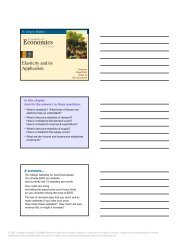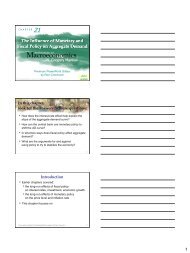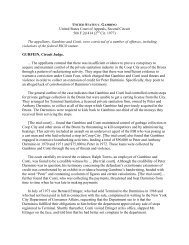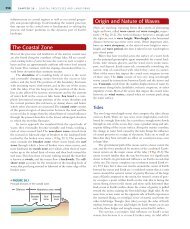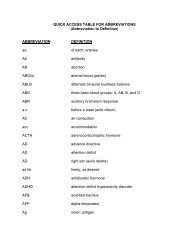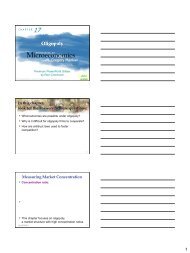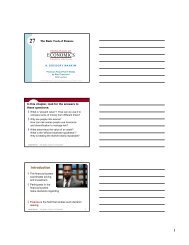Chapter 14 - Cengage Learning
Chapter 14 - Cengage Learning
Chapter 14 - Cengage Learning
You also want an ePaper? Increase the reach of your titles
YUMPU automatically turns print PDFs into web optimized ePapers that Google loves.
LEARNING OBJECTIVES<br />
At the end of this chapter the student should be able to:<br />
Understand quantitative data analysis.<br />
Analyze quantitative data.<br />
RESEARCH SKILLS<br />
At the end of this chapter the student should, using the exercises on the<br />
accompanying online platform, be able to:<br />
Carry out an analysis of the data set presented.<br />
Critique the data provided in terms of the stated aim of the research<br />
project.<br />
The aim of this chapter is to develop the focus on quantitative data and<br />
quantitative data analysis started in the previous chapter, and to teach you,<br />
the student, how to engage in quantitative data analysis. The chapter explains<br />
quantitative data analysis and the key concepts in quantitative data analysis.<br />
It demonstrates the processes involved in quantitative data analysis and basic<br />
statistical analysis. The use of visual displays of quantitative data analysis,<br />
charts and graphs, is explored and the importance of visual displays of<br />
quantitative data is explained.<br />
For use with Business Research Methods<br />
By Christina Quinlan<br />
ISBN <strong>14</strong>08007797 © 2011 <strong>Cengage</strong> <strong>Learning</strong>
ACTIVITY <strong>14</strong>.1<br />
ANSWER:<br />
RESEARCH DIARY ACTIVITIES<br />
Read through the case study presented in <strong>Chapter</strong> <strong>14</strong> of Lian’s research<br />
project. Record any thoughts or ideas that occur to you in your research diary.<br />
For use with Business Research Methods<br />
By Christina Quinlan<br />
ISBN <strong>14</strong>08007797 © 2011 <strong>Cengage</strong> <strong>Learning</strong>
ACTIVITY <strong>14</strong>.2<br />
Using the detail provided in <strong>Chapter</strong> <strong>14</strong> on Lian’s research project, carry out<br />
an analysis of Lian’s data. In your research diary write a brief account of that<br />
analysis.<br />
ANSWER:<br />
For use with Business Research Methods<br />
By Christina Quinlan<br />
ISBN <strong>14</strong>08007797 © 2011 <strong>Cengage</strong> <strong>Learning</strong>
ACTIVITY <strong>14</strong>.3<br />
Read Lian’s research statement and her aim and objectives. Then in your<br />
research diary, write a critique of the data Lian gathered in terms of the<br />
capacity of that data to provide insight into the phenomenon under<br />
investigation, as outlined in Lian’s research statement and in the aim and<br />
objectives of the research project.<br />
ANSWER:<br />
For use with Business Research Methods<br />
By Christina Quinlan<br />
ISBN <strong>14</strong>08007797 © 2011 <strong>Cengage</strong> <strong>Learning</strong>
ACTIVITY <strong>14</strong>.4<br />
Read the research project described in the Real World Research textbox on<br />
page 407 of the textbook. The journal article from which this synopsis was<br />
taken is entitled ‘Research Methods in the Leading Small Business-<br />
Entrepreneurship Journals: A Critical Review with Recommendations for<br />
Future Research’. When you have read the synopsis, source and read the<br />
entire journal article.<br />
In your research diary, make a note of the key argument made in the journal<br />
article; note too any ideas and/or thoughts that you have in relation to that<br />
argument.<br />
ANSWER:<br />
For use with Business Research Methods<br />
By Christina Quinlan<br />
ISBN <strong>14</strong>08007797 © 2011 <strong>Cengage</strong> <strong>Learning</strong>
ACTIVITY <strong>14</strong>.5<br />
In your research diary, make a list of five ideas for research projects. Develop<br />
each of these five ideas into researchable projects.<br />
ANSWER:<br />
For use with Business Research Methods<br />
By Christina Quinlan<br />
ISBN <strong>14</strong>08007797 © 2011 <strong>Cengage</strong> <strong>Learning</strong>
YOUR RESEARCH DIARY<br />
Please use this section to start your own Research Diary and keep accurate<br />
records of your research as it progresses<br />
DATE:<br />
RESEARCH ELEMENT/ASPECT:<br />
Detail the topic or section of research being undertaken<br />
SOURCE:<br />
Record website addresses, book citations, library references, contact details etc.<br />
For use with Business Research Methods<br />
By Christina Quinlan<br />
ISBN <strong>14</strong>08007797 © 2011 <strong>Cengage</strong> <strong>Learning</strong>
SUMMARY:<br />
Reflect on your experiences, thoughts, ideas and developments<br />
NOTES:<br />
Make general notes on your research, for example questions for further reflection and/or<br />
investigation, your thoughts, your observations and plans for future research.<br />
For use with Business Research Methods<br />
By Christina Quinlan<br />
ISBN <strong>14</strong>08007797 © 2011 <strong>Cengage</strong> <strong>Learning</strong>


